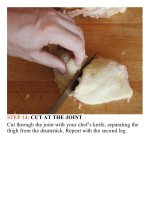The food lab better home cooking through science ( PDFDrive ) 247
Bạn đang xem bản rút gọn của tài liệu. Xem và tải ngay bản đầy đủ của tài liệu tại đây (91.74 KB, 2 trang )
S
hopping for broccoli and cauliflower is pretty
much the same and, luckily, finding good specimens
is not too difficult. These hearty members of the
brassica family have a good shelf life and are firm
enoughthattheydon’tbruiseorbreakeasilyduring
storageandshipping.Aheadofbroccolishouldhave
tight florets that are an even dark green with
greenish to purple buds. Cauliflower should be an
even pale white;yellow or brown spots should be
avoided, though if they are minor, you can simply
trim them off. Look to the leaves as well, which
should be tight around the base and appear bright
palegreen.
Once you get the broccoli or cauliflower home,
keep it loosely wrapped in plastic or in a vegetable
bag inside the crisper. It should stay good for at
leastaweek.Onceyou’vecutitintoflorets,it’sbest
to use it as quickly as possible to prevent excess
moisture loss, though florets can be stored in an
airtight container or zipper-lock plastic bag with a
damppapertowelplacedinitforupto5days.
KNIFESKILLS:
HowtoCutBroccoliand
Cauliflower
• ForBroccoli: Trimthewoodyendsofthestalksand
discard. Use the tip of your knife to cut off larger
branches, then cut the florets off the stalks and trim
to the desired shape and size. Cut any stubs off the
stalks and discard. Peel the stalks, quarter them
lengthwise,andsliceinto1-to2-inchlengthstocook
alongwiththeflorets.
• For Cauliflower: Split the head in half through the
center. Use the tip of a sharp knife to remove the
hardcentralcoreaswellasanygreenleavesaround
thebaseanddiscard.Breakthecauliflowerintolarge
chunkswithyourhands,thenusethetipofyourknife
tocutintofloretsofthedesiredsizeandshape.









